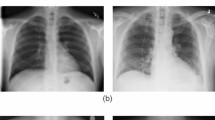Abstract
In this paper, we aimed at experimenting and developing suitable machine learning algorithms along with some deep learning architectures, to achieve the task of COVID-19 classification. We experimented with various supervised learning algorithms for the classification of COVID-19 images and normal images, from X-ray images and radiography images. We evaluated the performance of our models on performance metrics like accuracy, precision, recall, F1 score, and Cohen Kappa score. The proposed model achieved the accuracy of 98.5%, F1 score of 97%, precision of 95%, and Cohen Kappa score of 0.88. In this experiment, we jotted down the values of performance of various performance metrics, that were obtained after tuning various parameters of the model and on different image resolutions of input image. We performed linear regression on the results to study the behavior of various performance metrics when we tuned our model with different parameters with different input image resolutions.
Access this chapter
Tax calculation will be finalised at checkout
Purchases are for personal use only
Similar content being viewed by others
References
Ai, T., Yang, Z., Hou, H., Zhan, C., Chen, C., Lv, W., Tao, Q., Sun, Z., Xia, L.: Correlation of chest CT and RT-PCR testing for coronavirus disease 2019 (COVID-19) in china: a report of 1014 cases. Radiology 296(2), E32–E40 (2020)
Alpaydin, E.: Introduction to Machine Learning. MIT Press (2020)
Anastasopoulos, C., Weikert, T., Yang, S., Abdulkadir, A., Schmülling, L., Bühler, C., Paciolla, F., Sexauer, R., Cyriac, J., Nesic, I., et al.: Development and clinical implementation of tailored image analysis tools for COVID-19 in the midst of the pandemic: the synergetic effect of an open, clinically embedded software development platform and machine learning. Eur. J. Radiol. 131, 109233 (2020)
Apostolopoulos, I.D., Mpesiana, T.A.: COVID-19: automatic detection from X-ray images utilizing transfer learning with convolutional neural networks. Phys. Eng. Sci. Med. 43(2), 635–640 (2020)
Bonaccorso, G.: Machine Learning Algorithms. Packt Publishing Ltd (2017)
Brooks, W.A.: Bacterial pneumonia. In: Hunter’s Tropical Medicine and Emerging Infectious Diseases, pp. 446–453. Elsevier (2020)
Brunese, L., Martinelli, F., Mercaldo, F., Santone, A.: Machine learning for coronavirus COVID-19 detection from chest X-rays. Proc. Comput. Sci. 176, 2212–2221 (2020)
Burdick, H., Lam, C., Mataraso, S., Siefkas, A., Braden, G., Dellinger, R.P., McCoy, A., Vincent, J.L., Green-Saxena, A., Barnes, G., et al.: Prediction of respiratory decompensation in COVID-19 patients using machine learning: the ready trial. Comput. Biol. Med. 124, 103949 (2020)
Chang, Y.C., Chang, K.H., Wu, G.J.: Application of extreme gradient boosting trees in the construction of credit risk assessment models for financial institutions. Appl. Soft Comput. 73, 914–920 (2018)
Chowdhury, M.E., Rahman, T., Khandakar, A., Mazhar, R., Kadir, M.A., Mahbub, Z.B., Islam, K.R., Khan, M.S., Iqbal, A., Al Emadi, N., et al.: Can AI help in screening viral and COVID-19 pneumonia? IEEE Access 8, 132665–132676 (2020)
Dai, S., Li, L., Li, Z.: Modeling vehicle interactions via modified LSTM models for trajectory prediction. IEEE Access 7, 38287–38296 (2019)
Deng, X., Shao, H., Shi, L., Wang, X., Xie, T.: A classification-detection approach of COVID-19 based on chest X-ray and CT by using Keras pre-trained deep learning models. Comput. Model. Eng. Sci. 125(2), 579–596 (2020)
Fang, Y., Zhang, H., Xie, J., Lin, M., Ying, L., Pang, P., Ji, W.: Sensitivity of chest CT for COVID-19: comparison to RT-PCR. Radiology 296(2), E115–E117 (2020)
Hamed, A., Sobhy, A., Nassar, H.: Accurate classification of COVID-19 based on incomplete heterogeneous data using a KNN variant algorithm. Arab. J. Sci. Eng. 1–12 (2021)
Holmes, K.V.: Sars-associated coronavirus. New Engl. J. Med. 348(20), 1948–1951 (2003)
Huang, C., Wang, Y., Li, X., Ren, L., Zhao, J., Hu, Y., Zhang, L., Fan, G., Xu, J., Gu, X., et al.: Clinical features of patients infected with 2019 novel coronavirus in Wuhan, China. Lancet 395(10223), 497–506 (2020)
Jeni, L.A., Cohn, J.F., De La Torre, F.: Facing imbalanced data-recommendations for the use of performance metrics. In: 2013 Humaine Association Conference on Affective Computing and Intelligent Interaction, pp. 245–251. IEEE (2013)
Jin, X., Lian, J.S., Hu, J.H., Gao, J., Zheng, L., Zhang, Y.M., Hao, S.R., Jia, H.Y., Cai, H., Zhang, X.L., et al.: Epidemiological, clinical and virological characteristics of 74 cases of coronavirus-infected disease 2019 (COVID-19) with gastrointestinal symptoms. Gut 69(6), 1002–1009 (2020)
Khanday, A.M.U.D., Rabani, S.T., Khan, Q.R., Rouf, N., Din, M.M.U.: Machine learning based approaches for detecting COVID-19 using clinical text data. Int. J. Inf. Technol. 12(3), 731–739 (2020)
Kwekha-Rashid, A.S., Abduljabbar, H.N., Alhayani, B.: Coronavirus disease (COVID-19) cases analysis using machine-learning applications. Appl. Nanosci. 1–13 (2021)
Luke, J.J., Joseph, R., Balaji, M.: Impact of image size on accuracy and generalization of convolutional neural networks (2019)
Ozsahin, I., Sekeroglu, B., Mok, G.S.: The use of back propagation neural networks and 18F-Florbetapir PET for early detection of Alzheimer’s disease using Alzheimer’s disease neuroimaging initiative database. PLoS One 14(12), e0226577 (2019)
Pyrc, K., Jebbink, M., Vermeulen-Oost, W., Berkhout, R., Wolthers, K., Wertheim-van, P.D., Kaandorp, J., Spaargaren, J., Berkhout, B., et al.: Identification of a new human coronavirus. Nat. Med. 10(4), 368–373 (2004)
Yılmaz, N., Sekeroglu, B.: Student performance classification using artificial intelligence techniques. In: International Conference on Theory and Application of Soft Computing, Computing with Words and Perceptions, pp. 596–603. Springer (2019)
Author information
Authors and Affiliations
Corresponding author
Editor information
Editors and Affiliations
Rights and permissions
Copyright information
© 2023 The Author(s), under exclusive license to Springer Nature Singapore Pte Ltd.
About this paper
Cite this paper
Kumar, S., Tripathi, R. (2023). Detection of COVID-19 Using Machine Learning. In: Tistarelli, M., Dubey, S.R., Singh, S.K., Jiang, X. (eds) Computer Vision and Machine Intelligence. Lecture Notes in Networks and Systems, vol 586. Springer, Singapore. https://doi.org/10.1007/978-981-19-7867-8_13
Download citation
DOI: https://doi.org/10.1007/978-981-19-7867-8_13
Published:
Publisher Name: Springer, Singapore
Print ISBN: 978-981-19-7866-1
Online ISBN: 978-981-19-7867-8
eBook Packages: Intelligent Technologies and RoboticsIntelligent Technologies and Robotics (R0)




